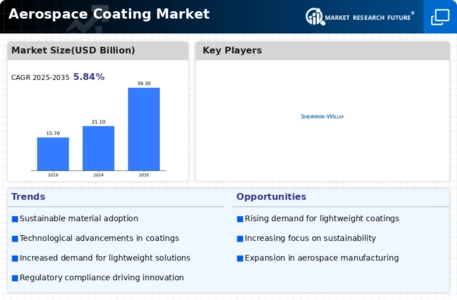Market Trends
Key Emerging Trends in the Aerospace Coatings Market
The aerospace coating market has been marked by significant trends, reflecting the intricate demands of the aerospace industry. Aerospace coatings are crucial for protecting aircraft surfaces from corrosion, erosion, and environmental factors while also enhancing their aesthetic appeal. Several key factors are shaping the market trends in the aerospace coating sector.
Raw materials costs are currently fluctuating widely. This can push the cost of the raw materials needed to make aerospace coatings up dramatically. The result is that airplane manufacturers have to use more expensive products which means that they have to produce fewer planes. The aerospace coatings industry has to find ways to keep its products in the affordable range even with wild fluctuations in the price of raw materials.
One notable trend in the aerospace coating market is the increasing demand for environmentally friendly and sustainable coating solutions. As the aerospace industry faces growing scrutiny over its environmental impact, there is a heightened focus on developing coatings with reduced volatile organic compound (VOC) emissions and environmentally responsible formulations. Manufacturers are investing in research and development to create water-based and eco-friendly aerospace coatings that meet stringent environmental regulations without compromising on performance. This trend aligns with the broader push towards sustainable practices across industries.
Technological advancements are playing a pivotal role in shaping the aerospace coating market. Continuous innovation in coating technologies, such as the development of smart coatings with self-healing properties, anti-icing capabilities, and enhanced durability, is gaining momentum. These advanced coatings contribute to the overall performance and longevity of aircraft surfaces, reducing maintenance costs and enhancing operational efficiency. The aerospace industry is increasingly adopting coatings with specialized functionalities to address specific challenges, such as extreme weather conditions and the need for increased fuel efficiency.
The growing importance of military aerospace applications is another key driver of market trends in the aerospace coating sector. Military aircraft operate in diverse and challenging environments, requiring coatings that provide superior protection and stealth capabilities. The development of coatings with radar-absorbing properties, low infrared signatures, and resistance to chemical and biological agents is gaining prominence in military aviation. The evolving geopolitical landscape and increased defense spending further contribute to the demand for advanced aerospace coatings tailored for military applications.
The shift towards lightweight materials in aircraft design is influencing market dynamics in the aerospace coating sector. As the aerospace industry emphasizes fuel efficiency and reduced emissions, there is a growing trend towards lightweight composite materials in aircraft construction. Coatings specifically formulated for these materials, offering corrosion resistance and compatibility with composite surfaces, are gaining importance. This trend is expected to continue as the aviation industry explores innovative materials to achieve weight reduction and enhance overall aircraft performance.
Global economic factors and regional dynamics also impact market trends in the aerospace coating industry. Economic growth, airline fleet expansions, and increasing air travel contribute to the demand for aerospace coatings. The Asia-Pacific region, in particular, has witnessed substantial growth in commercial aviation, with rising aircraft deliveries and maintenance activities. Moreover, regional regulations and standards, including those related to environmental protection and safety, influence the adoption of aerospace coatings in different markets.





Leave a Comment